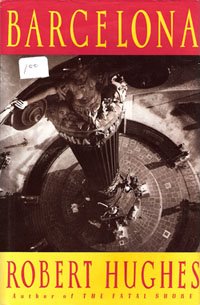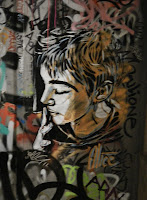Barcelona, Baby!
The strong vote for Catalan sovereignty on November 25, 2012, gives new occasion for re-reading Robert Hughes’s Barcelona, the serious traveler’s must-read adjunct to the Lonely Planet and DK travel guides. Mr. Hughes, recently deceased, was the art critic for Time magazine and had authored The Shock of the New and The Fatal Shore before bringing out Barcelona, an enormously successful critical survey of the art, architecture, and literature of the semi-autonomous Spanish region, Catalonia.
In Mr. Hughes’s Barcelona the Catalan people’s impulses toward political independence and distinct cultural identity reinforce each other through years of medieval empire and glory, centuries of subjugation and repression followed by the brilliant Art Nouveau flowering of the Catalan Renaixance including, most particularly, the beloved masterpieces of Antoni Gaudi. The vibrant urban scene laid before travelers today is largely beyond the scope of Hughes’s book, published 20 years ago, but it’s all there just as he describes it—the vast gothic quarter, largest extant in Europe; the leafy boulevards and elegant facades of the Eixample, Barcelona’s unique, also vast, Art Nouveau district; and the Catalan flags with the single star for independence hanging off balcony after balcony, street after street.
Unlike many great European cities, Barcelona was not defined by royalty and nobles. It’s a working town, and always has been. One hundred years before England’s Magna Carta, the Catalans limited their Aragon kings’ authority with their famous oath of allegiance:
“We, who are as good as you, swear to you, who are no better than us, to accept you as our king, provided that you observe all our liberties, and laws, but if not, not.”
Barcelona is a city of merchants, artisans, fishermen, sailors, and builders. Hughes saw their egalitarian spirit in the simple wide spaces of their civic buildings and spare churches, so unlike the frilly Gothic of aristocratic France with its long high naves enforcing hierarchy and class distinction. Barcelona’s spare Cathedral in the Barri Gotic is the widest of its era in Europe, places all Catalans near the altar and the holy relics, all Catalans by right, the same before God. The careful restorations and thoughtful public amenities of today’s Barri Gotic reveal a deep respect, even longing for the ancient independent Barcelona.
One afternoon my traveling companion and I wandered into a very old hat shop, deep in the Barri Gotic. The venerable haberdasher made a point to say, “Barcelona is Catalan, not Spanish.” When we brought up the November 25 elections, he shook his head and only said, “History.”
History—for three hundred years Barcelona became a stagnant city trapped behind its medieval walls, between two Spanish fortresses by their Castilian rulers. Little was done and little built, until the industrial revolution found native genius in Catalonia. They built manufacturing enterprises in the villages surrounding Barcelona and burst through the city walls creating the elegant district, Eixample. (Eixample is the Catalan word for extension or expansion.) Hughes discusses the Catalan nostalgia for rural life and their reverence for handicraft which contributed to Barcelona’s embrace of Art Nouveau as they were tripling the size of their city. Barcelona saw the natural forms of their Art Nouveau (Modernisme) as expressive of Catalan identity, as political assertion of power and rights—Catalan naturalism and elegance, as opposed to Castilian Neoclassicism and Baroque excess. Choral societies of working men sang traditional songs in the long forbidden Catalan tongue. A stained glass and tile Art Nouveau masterpiece, the Palau de la Musica, was created for their performances and is still in use. Here we enjoyed a performance by the Alyn String Quartet under an inverted stained glass dome.
This brings us to Antoni Gaudi, the star of the Catalan Renaixance, an architect whose popularity has grown to match Frank Lloyd Wright’s but whose works are all readily seen and easily toured walking through Barcelona. The highlights include Casa Mila, Parc Guell, Casa Batllo, Palau Guell, and the enormous civic landmark, the Sagrada Familia. Modern eyes see flowing Art Nouveau forms trending toward the surreal, but Hughes’s book helps us see these exquisitely crafted buildings through the eyes of Gaudi and Catalan nationalists. Since their political expression was repressed, their love of homeland found expression in Gaudi’s forms and symbols. St. George, the patron saint of Catalonia, slays the dragon on the roof of casa Battlo. The dragon’s bones and flowers decorate the façade. Here is a flowering of culture, architecture and political longing stamped out by events in history—WWI, economic depression, the Spanish Civil War and the brutal Franco dictatorship. Happily the buildings remain, meticulously maintained, still symbolizing the city’s aspirations.
And so Mr. Hughes’s book ends, but not before mentioning the great children of Barcelona’s Renaixance—Picasso, Dali, and Miro. One can still drink at The Four Cats where Picasso had his first show and visit the Picasso Museum both in the Barri Gotic. Dali has three museums in Catalonia, including one near Barcelona’s cathedral. Of the three Miro is most closely identified with Barcelona. He built his museum up on Montjuic near the Olympic stadium and filled it with his best work.
And so today Barcelona is experiencing its third great period of growth: the build-up for the 1992 Olympics and the long productive aftermath, maintaining its architectural heritage and building brilliant public spaces, displaying a native design excellence in everything from new monuments and sculpture to window dressing, door handles, and even graffiti. Barcelona is a world city. Recently a million Barcelonans poured out spontaneously onto the streets to demonstrate their readiness to take the world stage as the capital of Catalonia—independent again.
In Mr. Hughes’s Barcelona the Catalan people’s impulses toward political independence and distinct cultural identity reinforce each other through years of medieval empire and glory, centuries of subjugation and repression followed by the brilliant Art Nouveau flowering of the Catalan Renaixance including, most particularly, the beloved masterpieces of Antoni Gaudi. The vibrant urban scene laid before travelers today is largely beyond the scope of Hughes’s book, published 20 years ago, but it’s all there just as he describes it—the vast gothic quarter, largest extant in Europe; the leafy boulevards and elegant facades of the Eixample, Barcelona’s unique, also vast, Art Nouveau district; and the Catalan flags with the single star for independence hanging off balcony after balcony, street after street.
Unlike many great European cities, Barcelona was not defined by royalty and nobles. It’s a working town, and always has been. One hundred years before England’s Magna Carta, the Catalans limited their Aragon kings’ authority with their famous oath of allegiance:
“We, who are as good as you, swear to you, who are no better than us, to accept you as our king, provided that you observe all our liberties, and laws, but if not, not.”
Barcelona is a city of merchants, artisans, fishermen, sailors, and builders. Hughes saw their egalitarian spirit in the simple wide spaces of their civic buildings and spare churches, so unlike the frilly Gothic of aristocratic France with its long high naves enforcing hierarchy and class distinction. Barcelona’s spare Cathedral in the Barri Gotic is the widest of its era in Europe, places all Catalans near the altar and the holy relics, all Catalans by right, the same before God. The careful restorations and thoughtful public amenities of today’s Barri Gotic reveal a deep respect, even longing for the ancient independent Barcelona.
One afternoon my traveling companion and I wandered into a very old hat shop, deep in the Barri Gotic. The venerable haberdasher made a point to say, “Barcelona is Catalan, not Spanish.” When we brought up the November 25 elections, he shook his head and only said, “History.”
History—for three hundred years Barcelona became a stagnant city trapped behind its medieval walls, between two Spanish fortresses by their Castilian rulers. Little was done and little built, until the industrial revolution found native genius in Catalonia. They built manufacturing enterprises in the villages surrounding Barcelona and burst through the city walls creating the elegant district, Eixample. (Eixample is the Catalan word for extension or expansion.) Hughes discusses the Catalan nostalgia for rural life and their reverence for handicraft which contributed to Barcelona’s embrace of Art Nouveau as they were tripling the size of their city. Barcelona saw the natural forms of their Art Nouveau (Modernisme) as expressive of Catalan identity, as political assertion of power and rights—Catalan naturalism and elegance, as opposed to Castilian Neoclassicism and Baroque excess. Choral societies of working men sang traditional songs in the long forbidden Catalan tongue. A stained glass and tile Art Nouveau masterpiece, the Palau de la Musica, was created for their performances and is still in use. Here we enjoyed a performance by the Alyn String Quartet under an inverted stained glass dome.
This brings us to Antoni Gaudi, the star of the Catalan Renaixance, an architect whose popularity has grown to match Frank Lloyd Wright’s but whose works are all readily seen and easily toured walking through Barcelona. The highlights include Casa Mila, Parc Guell, Casa Batllo, Palau Guell, and the enormous civic landmark, the Sagrada Familia. Modern eyes see flowing Art Nouveau forms trending toward the surreal, but Hughes’s book helps us see these exquisitely crafted buildings through the eyes of Gaudi and Catalan nationalists. Since their political expression was repressed, their love of homeland found expression in Gaudi’s forms and symbols. St. George, the patron saint of Catalonia, slays the dragon on the roof of casa Battlo. The dragon’s bones and flowers decorate the façade. Here is a flowering of culture, architecture and political longing stamped out by events in history—WWI, economic depression, the Spanish Civil War and the brutal Franco dictatorship. Happily the buildings remain, meticulously maintained, still symbolizing the city’s aspirations.
And so Mr. Hughes’s book ends, but not before mentioning the great children of Barcelona’s Renaixance—Picasso, Dali, and Miro. One can still drink at The Four Cats where Picasso had his first show and visit the Picasso Museum both in the Barri Gotic. Dali has three museums in Catalonia, including one near Barcelona’s cathedral. Of the three Miro is most closely identified with Barcelona. He built his museum up on Montjuic near the Olympic stadium and filled it with his best work.
And so today Barcelona is experiencing its third great period of growth: the build-up for the 1992 Olympics and the long productive aftermath, maintaining its architectural heritage and building brilliant public spaces, displaying a native design excellence in everything from new monuments and sculpture to window dressing, door handles, and even graffiti. Barcelona is a world city. Recently a million Barcelonans poured out spontaneously onto the streets to demonstrate their readiness to take the world stage as the capital of Catalonia—independent again.
Gaudi Gallery
Sagrada Familia
Casa Batllo
Casa Mila
Parc Guell
Palau Guell
Other Photos
























Comments